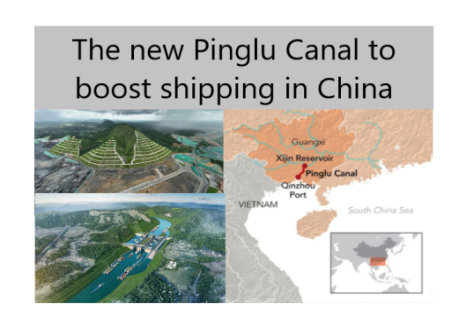China kicked off construction of the 135km-long Pinglu Canal in the Guangxi Zhuang autonomous region in August. When completed, the canal will shorten the shipping distance from inland river systems to the sea by 560 km, versus going through Guangzhou. By creating a convenient and economical gateway close to Southeast Asia, the waterway also promises to boost industries in Guangxi and other parts of relatively less-developed western China.
The project links Guangxi’s capital city of Nanning with the Beibu Gulf. It has a total length of 134.2 kilometres and a designed one-way annual capacity of 89 million tons. The canal starts at the Xijin reservoir in the city of Hengzhou and ends at Luwu town of Lingshan county of Qinzhou, where ships can reach the Beibu Gulf via the Qinjiang River.
The 72.7 billion yuan (US$10.3 billion) canal complements existing highways and railways to move goods. It is estimated that it will save up to 5.2 billion yuan annually. Work is being carried out on a 24-hour basis.
Launched last year, the project highlights Beijing’s shifting focus toward enhancing maritime connectivity for its Belt and Road Initiative, as opposed to land routes. Guangxi government officials say the emerging corridor has already accelerated logistics – speeding up shipments from Chongqing in western China to Singapore to seven days, from 22.
Thanks to the updated procedure for certificate of origin – export documentation available online under the Regional Comprehensive Economic Partnership (RCEP) – customs clearance has been cut from three days to just one-to-two minutes, according to Asia Pulp and Paper which is located in Qinzhou.
About 40 km away from the construction site, a line of driverless trucks transport 20-foot shipping containers to the Qinzhou Automated Container Terminal – called an ‘Intelligent Port.’ As they arrive at the terminal, computer-operated cranes pick up the containers and load them onto a berthed cargo vessel.
The Pinglu Canal is aimed at boosting already growing trade with the 10 members of the Association of Southeast Asian Nations, all of which are grouped with China under the RCEP free trade framework. It will also boost ASEAN – this organization and China are already each other’s largest trade partners, with two-way trade rising 52% from 2019 to 2022 – well exceeding the 20% increase in trade with the European Union.
Both foreign and local manufacturers in Qinzhou say they are beginning to feel the effects of the upgraded port facilities, as well as RCEP benefits. The trade deal, also signed by Japan, South Korea, Australia and New Zealand, took effect last year. It eliminates 90% of tariffs on goods traded between the signatories.
Upon completion, the canal will not only support the development of its region but also become the shortest, most economical and most convenient sea outlet in southwestern China.
There are hundreds of shipping canals all over the world, in different length, width and depth, facilitating easy movement of a variety of vessels on an everyday basis. Some of these canals are also the busiest traffic routes around the world. They are of vital importance in the maritime industry as they offer shorter transportation routes across major seawater networks and also help to regulate maritime traffic internally within countries.
The most well-known canals in the world are:
- Panama Canal – the Atlantic Ocean and the Pacific Ocean
- Suez Canal – the Mediterranean Sea and the Red Sea
- Erie Canal – Lake Erie and the Hudson River
- Grand Canal – Beijing and Zhejiang
- Bruges Canal – Bruges and the North Sea
- Rhine-Main-Danube Canal – the North Sea to the Black Sea
- White Sea Canal – the White Sea to the Baltic Sea
- Houston Ship Canal – Texas to the Gulf of Mexico
- Volga-Don Canal – links the Azov and Caspian Seas to the main oceans
- Kiel Canal (Nord-Ostsee-Kanal) – the busiest waterway in Europe
- Corinth Canal – the narrowest canal in the world. Connecting the Corinthian Gulf of the Ionian Sea and the Saronic Gulf of the Aegean Sea.
Read our related article: Resuming Trade Talks with China.
For more information about international shipping – whether with the China or any other point on the globe – contact us here at Colless Young. As licensed Customs Brokers and International Freight Forwarders we offer correct, professional advice on all your import and export trade transactions. We are based in Brisbane and provide a complete range of logistics services, for both airfreight and sea cargo through all Australian ports and airports.

